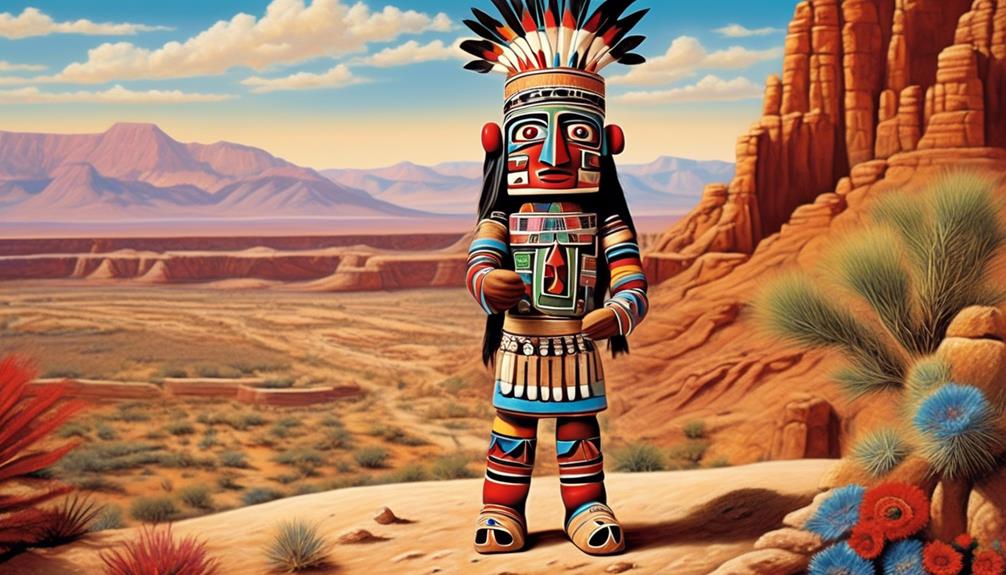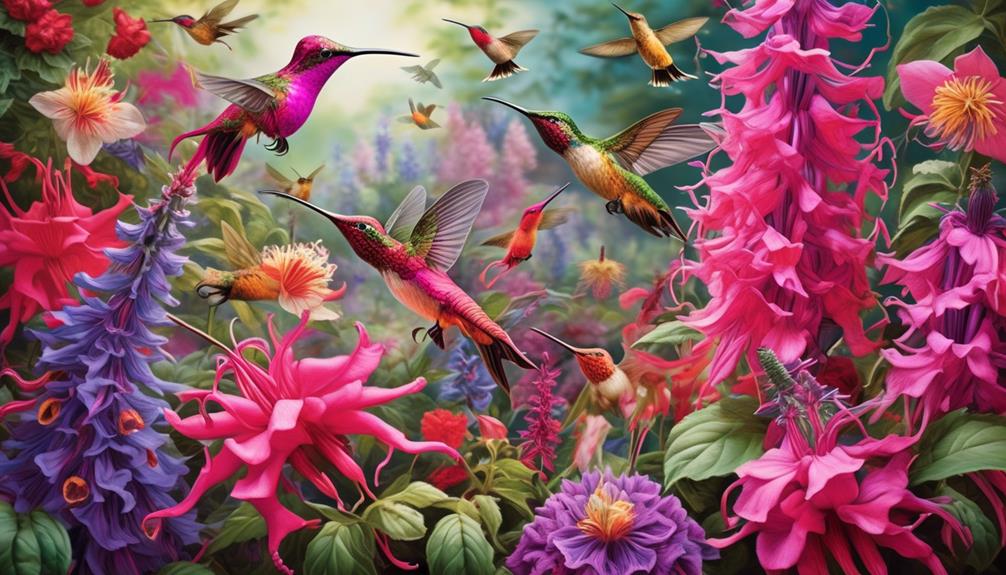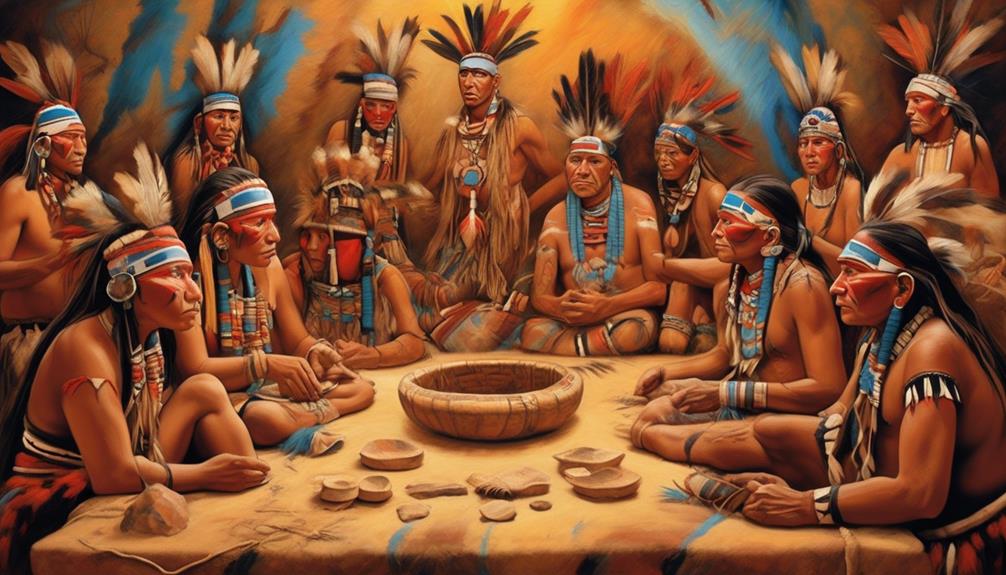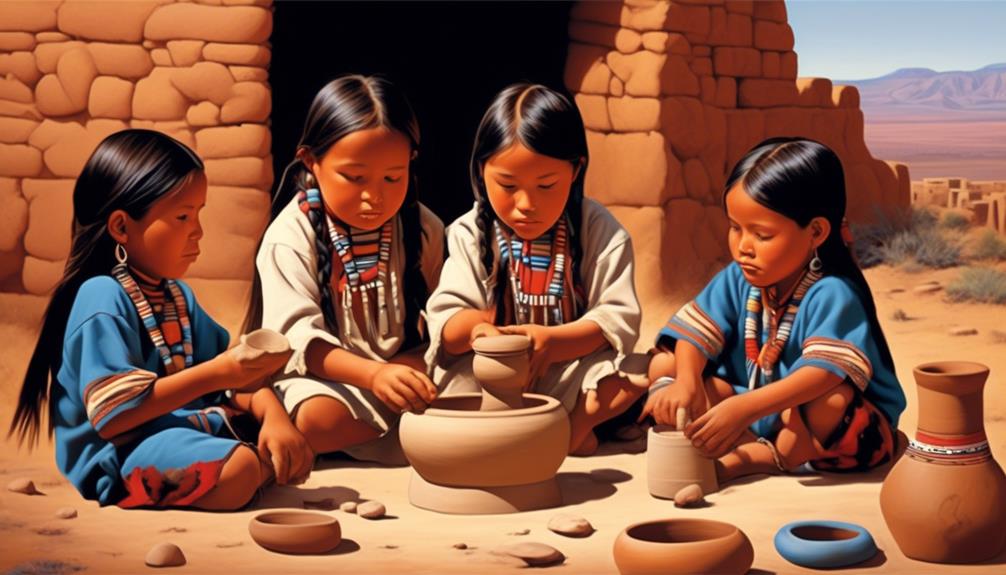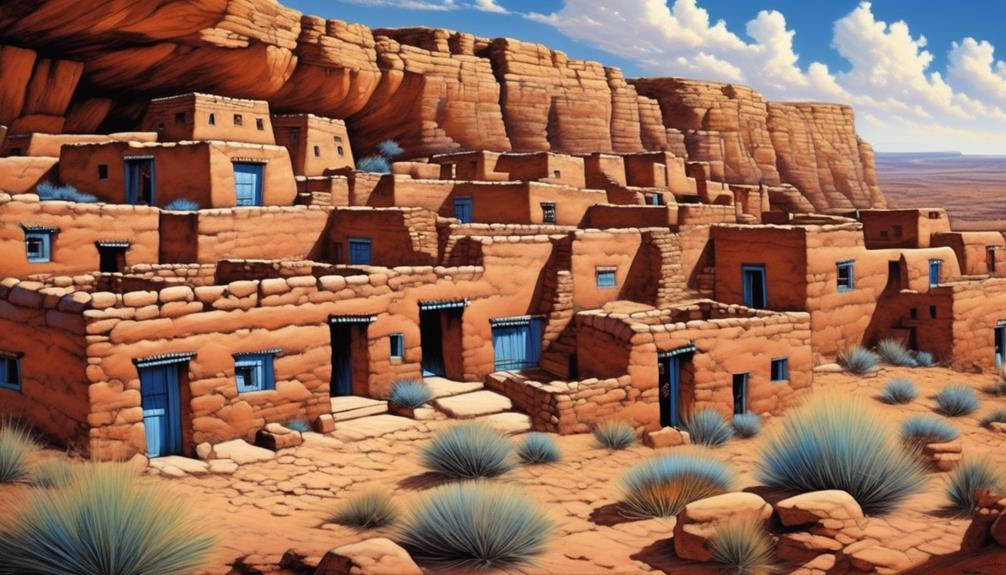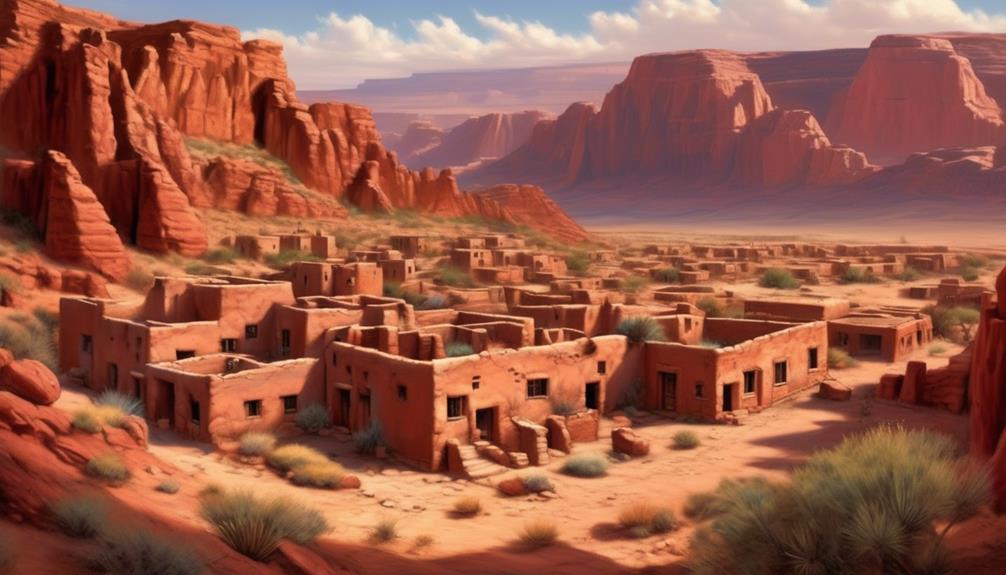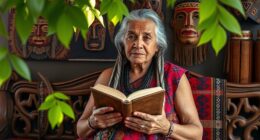Studying the history and traditions of the Hopi tribe reveals that their cultural heritage is complex and abundant, resembling a finely woven tapestry.
The Hopi people have a rich and storied past, filled with unique customs and beliefs that have stood the test of time.
From their ancient prophecies to the significance of Kachina dolls, there is much to uncover about this fascinating tribe.
Key Takeaways
- The Hopi tribe has a strong cultural identity and spiritual beliefs that are shaped by ancient Hopi prophecy and traditions.
- The unique Hopi villages are located atop mesas and valleys in northeastern Arizona, characterized by compact, terraced, multi-story buildings made of stone and adobe.
- Kachina dolls hold great significance in Hopi culture, representing spiritual beings and serving as a means to educate the younger generation about traditions and values.
- The Hopi tribe practices sustainable farming techniques, emphasizing water conservation, crop rotation, and diverse maize varieties adapted to arid conditions.
Ancient Hopi Prophecy and Traditions
The ancient Hopi prophecy and traditions have been passed down through generations, shaping the cultural identity and spiritual beliefs of the Hopi people. Hopi traditions are deeply rooted in a profound connection to the land and a harmonious way of life. The Hopi people believe in the ancient prophecy of the emergence into the current world, which guides their actions and decisions. This prophecy outlines the spiritual path and responsibilities of the Hopi people, emphasizing the importance of living in balance with nature and each other.
Hopi traditions are woven into every aspect of daily life, from ceremonies and rituals to art and agriculture. The Hopi have a rich oral tradition that preserves their history, cosmology, and spiritual teachings. Through storytelling, song, and dance, the Hopi pass down their traditions from one generation to the next, ensuring the continuity of their cultural practices and beliefs.
The ancient prophecy and traditions provide the Hopi people with a strong sense of identity and purpose. It fosters a deep respect for the earth and all living beings, guiding the Hopi towards a way of life that promotes harmony and balance. These traditions continue to be a source of resilience and guidance for the Hopi people in the modern world.
Unique Hopi Villages and Architecture
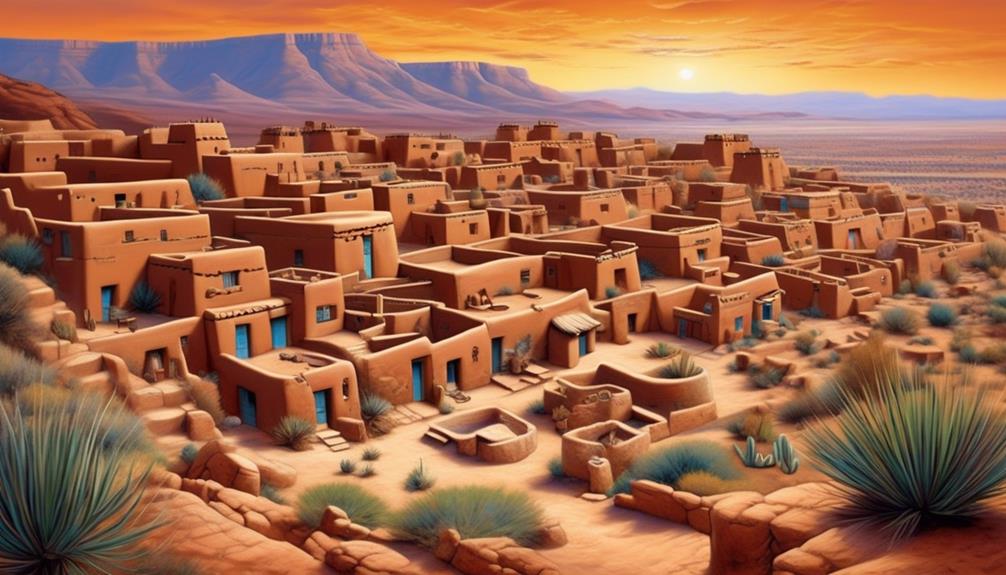
Nestled atop the mesas and valleys of northeastern Arizona, the Hopi villages showcase a distinctive architectural style that reflects their deep connection to the land and their enduring cultural heritage.
Hopi architecture is characterized by compact, terraced, multi-story buildings made of stone and adobe, often with flat roofs. The village layout is designed with narrow, winding streets and plaza areas, fostering a sense of community and shared space. Traditional dwellings, known as pueblos, are constructed using age-old building techniques that have been passed down through generations, emphasizing sustainability and harmony with the environment.
Ceremonial spaces within the villages, such as kivas, are integral to the architectural symbolism of the Hopi people. Kivas are subterranean structures used for religious rituals and gatherings, embodying the spiritual essence of the tribe. The architectural design of kivas reflects the Hopi's cosmological beliefs and their reverence for the natural world.
In essence, Hopi architecture is more than just physical structures; it's a manifestation of their cultural identity and values, serving as a testament to their enduring traditions and connection to the land.
Significance of Kachina Dolls in Hopi Culture
Exploring the rich cultural heritage of the Hopi tribe, we're drawn to the profound significance of Kachina dolls in their traditional practices and belief systems. The Kachina symbolism embodies the spirits of deities, ancestors, and natural elements, playing a central role in various Hopi ceremonies and rites of passage. Crafted with meticulous attention to detail, these dolls reflect the exquisite artistry and spiritual devotion of Hopi craftsmanship.
Here are some key aspects of the significance of Kachina dolls in Hopi culture:
- Spiritual Connections: Kachina dolls serve as tangible representations of spiritual beings, fostering a deep connection between the Hopi people and their religious beliefs.
- Teaching Tools: These dolls are used to educate the younger generation about tribal traditions, societal values, and the natural world, ensuring the continuity of cultural knowledge.
- Harmonizing Forces: Through ceremonial dances and rituals involving Kachina dolls, the Hopi seek to maintain balance and harmony within their community and with the natural environment.
- Cultural Preservation: The creation and use of Kachina dolls are integral to preserving the rich heritage and traditions of the Hopi tribe for future generations.
Hopi Agricultural and Farming Practices
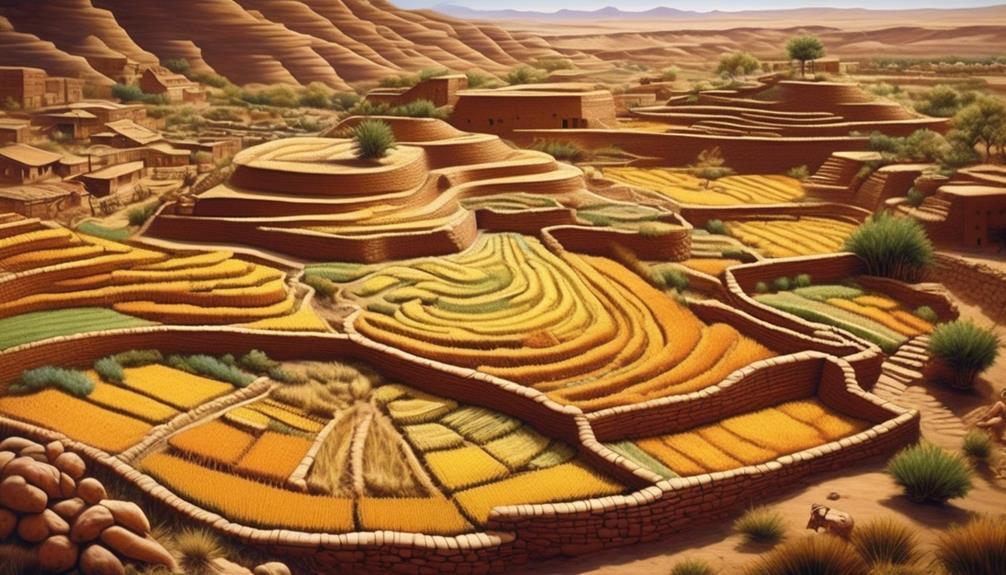
Embracing a deep connection to the land and a profound understanding of sustainable agriculture, the Hopi tribe practices traditional farming techniques that have been passed down through generations. These traditional techniques are deeply rooted in the Hopi way of life and reflect a harmonious relationship with nature. Water conservation and crop rotation are fundamental aspects of their agricultural practices, allowing for sustainable farming and the preservation of the environment.
To showcase the agricultural practices of the Hopi tribe, the following table provides an overview of their traditional farming techniques:
| Traditional Farming Techniques | Description | Purpose |
|---|---|---|
| Dry Farming | Cultivating crops without | To conserve water in arid regions |
| irrigation in arid regions | ||
| Corn, Beans, and Squash | Three Sisters farming | Promotes soil fertility and crop |
| method | rotation for sustainable agriculture | |
| Kiva Gardens | Community farming plots | Encourages cooperation and |
| for growing crops | sustainability | |
| Hopi Maize Varieties | Diverse maize varieties | Preserves genetic diversity and |
| adapted to arid conditions | ensures food security | |
| Hopi Seed Preservation | Traditional seed saving | Protects indigenous crop varieties |
| practices | for future generations |
The Hopi tribe's commitment to sustainable farming is evident in their conservation practices and dedication to preserving traditional agricultural knowledge.
Hopi Ceremonies and Rituals
Hopi Ceremonies and Rituals hold a central place in the spiritual and cultural traditions of the Hopi tribe, reflecting their deep reverence for the natural world and the interconnectedness of all life.
Ceremonial dances are a significant aspect of Hopi traditions, with each dance embodying a specific spiritual meaning and purpose. These dances often depict stories of creation, migration, and the relationships between the Hopi people and their deities.
Prayer offerings are an essential part of Hopi ceremonies, symbolizing gratitude and seeking blessings for the community, the land, and the harvest. The timing of these rituals is intricately connected to the agricultural calendar, aligning with the planting and harvesting seasons.
The Katsina ceremonies are also central to Hopi traditions, involving the veneration of ancestral spirits and the performance of elaborate dances. These ceremonies aren't merely performances but are deeply spiritual and are believed to bring rain, fertility, and prosperity to the Hopi people and their lands.
Frequently Asked Questions
How Did the Hopi Tribe Adapt to Changes in Their Environment Over Time?
We, the Hopi tribe, have adapted to environmental changes through various strategies. Our agricultural practices, such as dry farming and the use of terraced fields, have enabled us to thrive in arid conditions.
Additionally, our spiritual beliefs and ceremonies are deeply connected to the land, guiding us in sustainable resource management.
What Role Do Women Play in Hopi Ceremonies and Rituals?
In Hopi ceremonies and rituals, women hold significant roles, contributing to the cultural tapestry through their wisdom and guidance. Their presence symbolizes the nurturing and life-giving aspects of the tribe's traditions, fostering a deep emotional connection with the community.
Women's roles are integral to maintaining the spiritual and cultural harmony, emphasizing the profound respect and reverence for their contributions. The Hopi tribe's ceremonies and rituals embody the interconnectedness of women's roles with the tribe's cultural significance.
How Does the Hopi Tribe View the Concept of Time and History?
We view the concept of time and historical perspective as integral to our culture.
The Hopi tribe has a strong connection to our ancestors and their traditions, which shapes our understanding of time and history.
Our ceremonies and rituals reflect this deep respect for the past and the importance of passing down our traditions to future generations.
This perspective helps us maintain a strong cultural identity and a sense of continuity within our community.
What Are Some Traditional Hopi Healing Practices and Medicinal Herbs Used by the Tribe?
Traditional healing within the Hopi Tribe involves a deep connection to nature and the use of herbal remedies. These practices reflect the tribe's profound understanding of the natural world and its healing properties.
Through generations, we've cultivated a wealth of knowledge about medicinal herbs and their applications, passing down this wisdom to preserve our cultural heritage.
Our traditional healing practices are a testament to the resilience and wisdom of the Hopi people.
How Do the Hopi Maintain Their Language and Traditional Stories in Modern Times?
We maintain our language through immersion in daily life and educational programs. Our storytelling techniques, passed down through generations, help preserve traditional stories and language.
Elders share wisdom orally, ensuring the continuity of our heritage. Our commitment to language preservation strengthens our cultural identity and fosters a deep connection to our ancestors.
This dedication to our traditions is vital for the Hopi people and serves as a guiding light for future generations.
Conclusion
In conclusion, the Hopi Tribe's ancient prophecy, unique villages, Kachina dolls, agricultural practices, and ceremonial rituals showcase their rich and diverse culture.
Their deep traditions and spiritual beliefs have stood the test of time, making the Hopi Tribe an intriguing and captivating group to learn about.
Their enduring legacy continues to fascinate and inspire people from all walks of life.
Mary is a passionate writer who brings creativity and a fresh perspective to our team. Her words have the power to captivate and inspire, making her an essential contributor to our content. Mary’s commitment to storytelling and dedication to promoting Indigenous culture ensures that her work touches the hearts of our readers. We’re fortunate to have her as part of our team.
